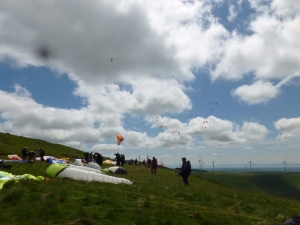Status: Members Only |
|
|---|---|
| Site Latitude:N51.633150 | Height ASL Meters:490m |
| Site Longitude:W003.525706 | Height ASL Feet:1600ft |
| Wind Direction:SSW-WSW | Height Top to Bottom Meters:335 |
| Best Direction: SW | Height Top to Bottom Feet:1100 |
| Minimum BHPA Rating Hang Gliding: BHPA Pilot rating | Member status:Members Only |
| Minimum BHPA Rating Paragliding:BHPA Club Pilot rating | OS Grid Reference and Prefix:SS 944 938 |
Latitude: N51.639263
Longitude: W003.534609
Latitude: N51.633084
Longitude: W003.525731
Take-off

Looking along the Nant-y-moel take-off to the west. Photo courtesy of Marcus Woodbridge.
Landing

A busy take-off on Mynydd William Meyrick (Nant-y-Moel) at the British Club Challenge. Photo courtesy of Alan Hole.
Top Landing General
South East Wales sites often have very large, undefined take off and top landing areas, which may change position according to conditions. To avoid the potential for collision, pilots making a top landing should keep well away from gliders taking off, who may in some cases have limited visibility.
Flying

Looking east towards the wind farms at Nant-y-moel. Photo courtesy of Marcus Woodbridge.
Hazards
TBC
All rights belong to Google Inc. SEWHGPGC is a nonprofit making organisation.
If you require further advice about a particular SEWHGPGC site please contact a Club Coach. Please report all accidents to The Club Safety & Training Officer Steve Millson and the BHPA. Please visit the BHPA for the most current Incident Report Form.
This document is a guide only.
We advise that anyone Hang Gliding and Paragliding conduct a dynamic risk assessment prior to flying any site. This should be continuously re-assessed due to the changeable conditions of the outdoor environment.
All individuals are advised to take the following into account when making their dynamic risk assessment:
Paragliding and Hang Gliding are dangerous sports that can cause serious injury including bodily harm, paralysis and death. Flying SEW sites is undertaken with the full knowledge that Paragliding and Hang Gliding involves such risks. As the pilot you take exclusive responsibility for all risks associated with your part taking in the sport.
Any liability claims towards the club are excluded.
If you are not sure. DO NOT FLY.
In the Mountains/Rivers/Lakes
Dial 999/112 and ask for the Police and then Mountain Rescue. If you are away from the road side then dial 999/112 and ask for the Police and then Mountain Rescue explaining your circumstances. If you cannot make voice calls, you can now contact the 999 Emergency Services by SMS. NB you must register this prior to an emergency.
In an emergency 999 need to know:
Who is Calling?
Your name and mobile number.
What?
Briefly, what is the problem, including the state of the casualty. Ensure you use the buzzword Fall From Height
and Remote Location.
Where?

